The AMD 3rd Gen Ryzen Deep Dive Review: 3700X and 3900X Raising The Bar
by Andrei Frumusanu & Gavin Bonshor on July 7, 2019 9:00 AM EST** = Old results marked were performed with the original BIOS & boost behaviour as published on 7/7.
Benchmarking Performance: CPU Rendering Tests
Rendering is often a key target for processor workloads, lending itself to a professional environment. It comes in different formats as well, from 3D rendering through rasterization, such as games, or by ray tracing, and invokes the ability of the software to manage meshes, textures, collisions, aliasing, physics (in animations), and discarding unnecessary work. Most renderers offer CPU code paths, while a few use GPUs and select environments use FPGAs or dedicated ASICs. For big studios however, CPUs are still the hardware of choice.
All of our benchmark results can also be found in our benchmark engine, Bench.
Corona 1.3: Performance Render
An advanced performance based renderer for software such as 3ds Max and Cinema 4D, the Corona benchmark renders a generated scene as a standard under its 1.3 software version. Normally the GUI implementation of the benchmark shows the scene being built, and allows the user to upload the result as a ‘time to complete’.
We got in contact with the developer who gave us a command line version of the benchmark that does a direct output of results. Rather than reporting time, we report the average number of rays per second across six runs, as the performance scaling of a result per unit time is typically visually easier to understand.
The Corona benchmark website can be found at https://corona-renderer.com/benchmark
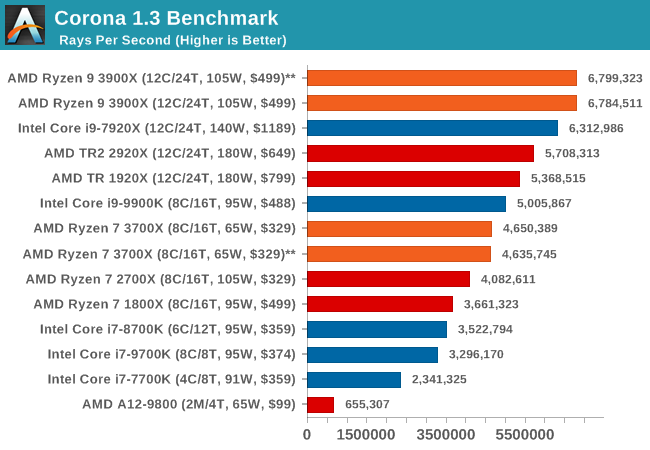
LuxMark v3.1: LuxRender via Different Code Paths
As stated at the top, there are many different ways to process rendering data: CPU, GPU, Accelerator, and others. On top of that, there are many frameworks and APIs in which to program, depending on how the software will be used. LuxMark, a benchmark developed using the LuxRender engine, offers several different scenes and APIs.

Taken from the Linux Version of LuxMark
In our test, we run the simple ‘Ball’ scene on both the C++ and OpenCL code paths, but in CPU mode. This scene starts with a rough render and slowly improves the quality over two minutes, giving a final result in what is essentially an average ‘kilorays per second’.

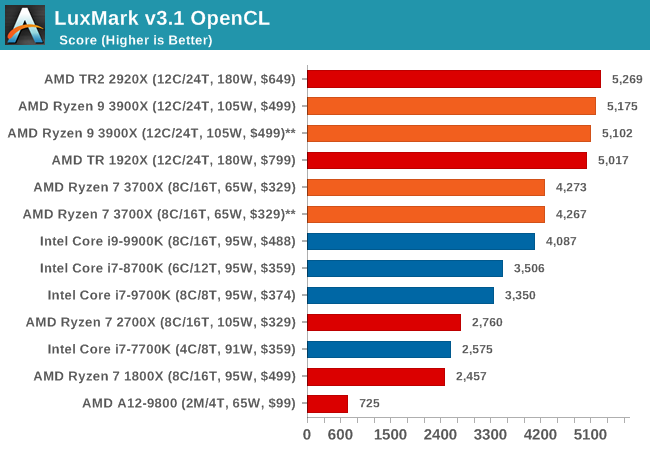
POV-Ray 3.7.1: Ray Tracing
The Persistence of Vision ray tracing engine is another well-known benchmarking tool, which was in a state of relative hibernation until AMD released its Zen processors, to which suddenly both Intel and AMD were submitting code to the main branch of the open source project. For our test, we use the built-in benchmark for all-cores, called from the command line.
POV-Ray can be downloaded from http://www.povray.org/
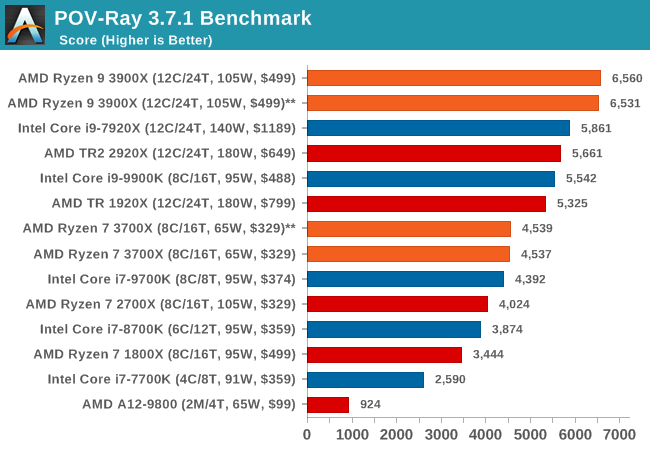
Cinebench R15
The latest version of CineBench has also become one of those 'used everywhere' benchmarks, particularly as an indicator of single thread performance. High IPC and high frequency gives performance in ST, whereas having good scaling and many cores is where the MT test wins out.
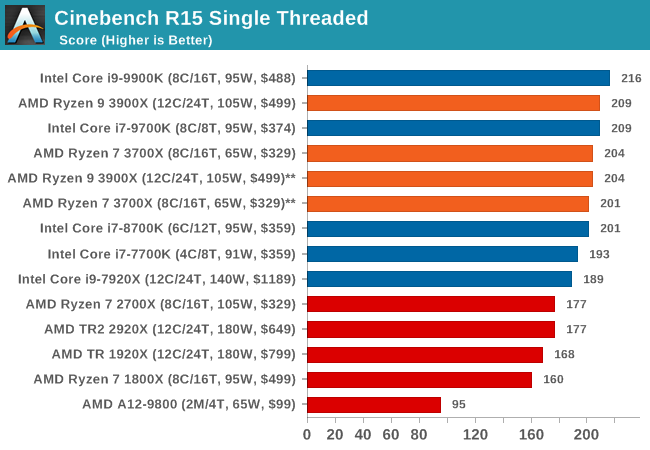
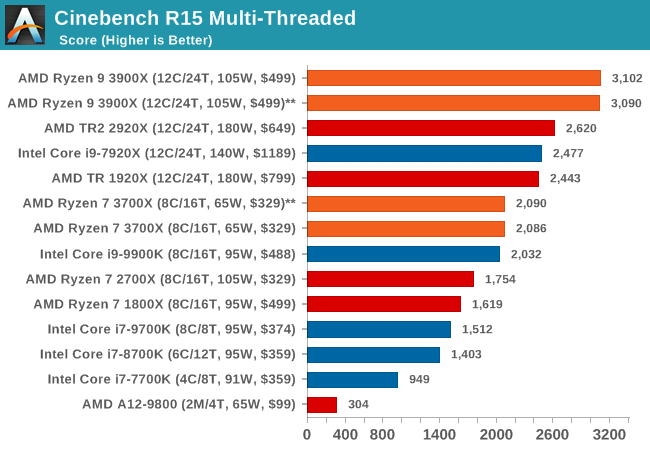











447 Comments
View All Comments
Tkan215 - Monday, July 8, 2019 - link
I dont think so its not easy to refine 10nm like you think how many year it take Intel to refine 10nm it has been already 4 to 5 years dont get your hope up. If volume aint there there is no chance. AMD surelly moving to 7nm euv quicker then 5nmTkan215 - Monday, July 8, 2019 - link
I havent seen them drop any price i9900k went back up at amazon.com. Intel continue to ignore, non response and not caring for their competition. they want their margin this is all this company care about not your feeling or desireTEAMSWITCHER - Sunday, July 7, 2019 - link
It's summer time in Michigan and I have no desire to upgrade right now... I can wait for the flagship 3950X in September.Maxiking - Sunday, July 7, 2019 - link
Local anandtech yield and node experts got hit again. I wonder how many hits you can take before you shut up.As predicted, Intel still faster in games and AMD OC ability more or less unchanged, slighty worse. It is a new node after all buy yeah, you know better, so keep dreaming about those 5ghz on the majority of chips.
Teckk - Sunday, July 7, 2019 - link
So more cores at the same TDP as 2000 series Ryzen is nothing? Ok.Maxiking - Sunday, July 7, 2019 - link
That isn't the thing I was talking about. My point was that local experts, I mean, trolls, know nothing about the manufacturing cost, yields, about the node in general. As it has been showed recently in the reviews, OC ability of the chips is terrible and lower core count parts tend to perform worse, reaching only 4.1 - 4.2 ghz.Teckk - Sunday, July 7, 2019 - link
Ah, got it. It is an improvement, but not good enough.Maxiking - Sunday, July 7, 2019 - link
It is good enough in terms of competition and that we can get things cheaper.But not when the raw performance is tconsidered. It is a hypothetical scenario, but had there been no 10 nm problems for Intel, AMD would have been in the bulldozer position again.
catavalon21 - Sunday, July 7, 2019 - link
I haven't owned an AMD CPU since my K500 a very long time ago, but let's call it what it is - AMD has a CPU at the $500 price point that Intel is charging $1200 presently to compete with, and Intel's solution uses far more power. That's a win for AMD in any domain.imaheadcase - Sunday, July 7, 2019 - link
The problem is that the PC market is stagnant atm, if you are already a intel owner, absolutely no reason to upgrade to amd CPU. Most people who have systems now don't really have any need to upgrade like it used to be.He stated in article it took amd 15 YEARS to get this good CPU finally out and sounded like he was impressed by that?
Its a impressive CPU, but lets be real here, Intel has dominated the market already for years because it has better marketing, better suppliers.
Based on previous article comments, most people are still rocking 2600K CPU..FROM 2011! They still are very good CPU.
Thats not counting the price difference, while yes the one intel cpu is crazy expensive, its not a normal CPU most people have to go by, if you a regular user with the previous mentioned 2600K CPU..that requires a total system overhaul if you wanted to go AMD route...which to be honest is a risk on betting that a new amd system is not going to last as long as a 2600K did for you.